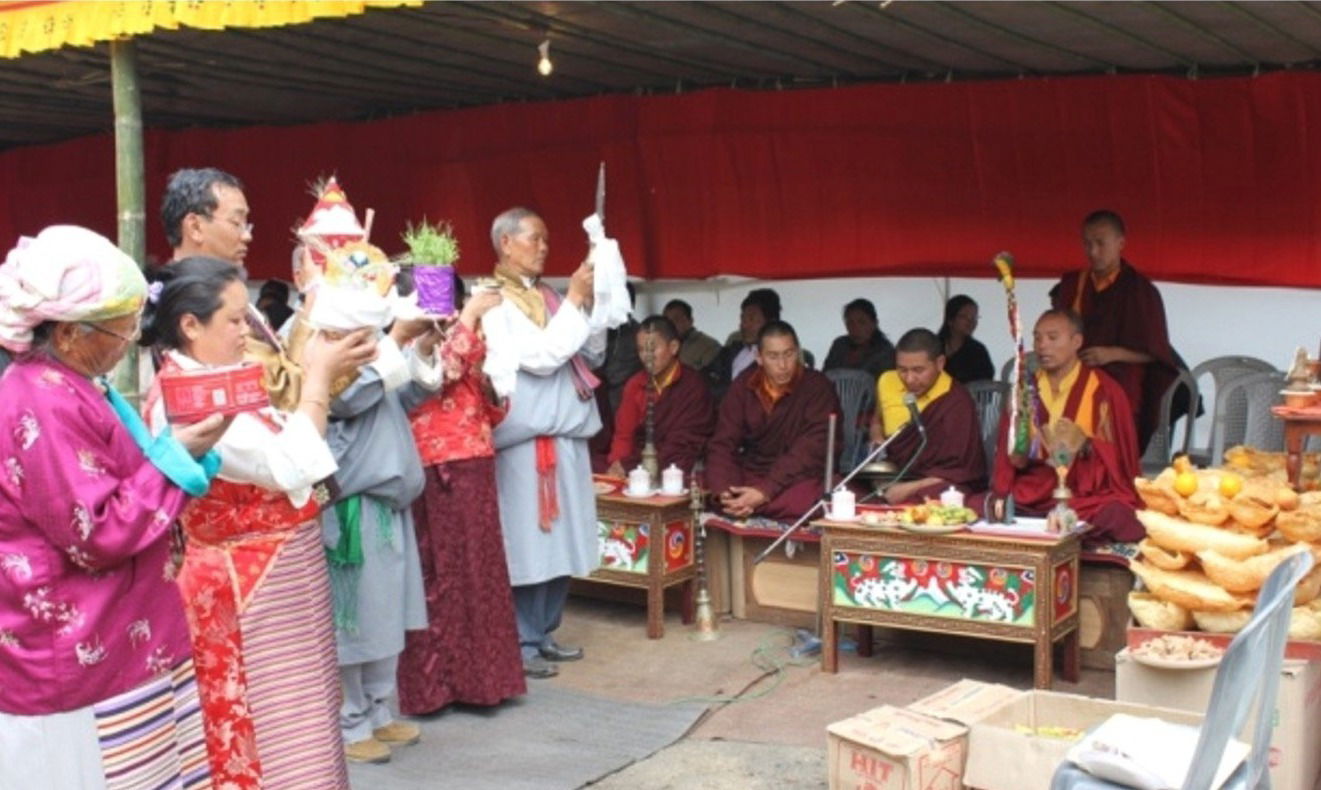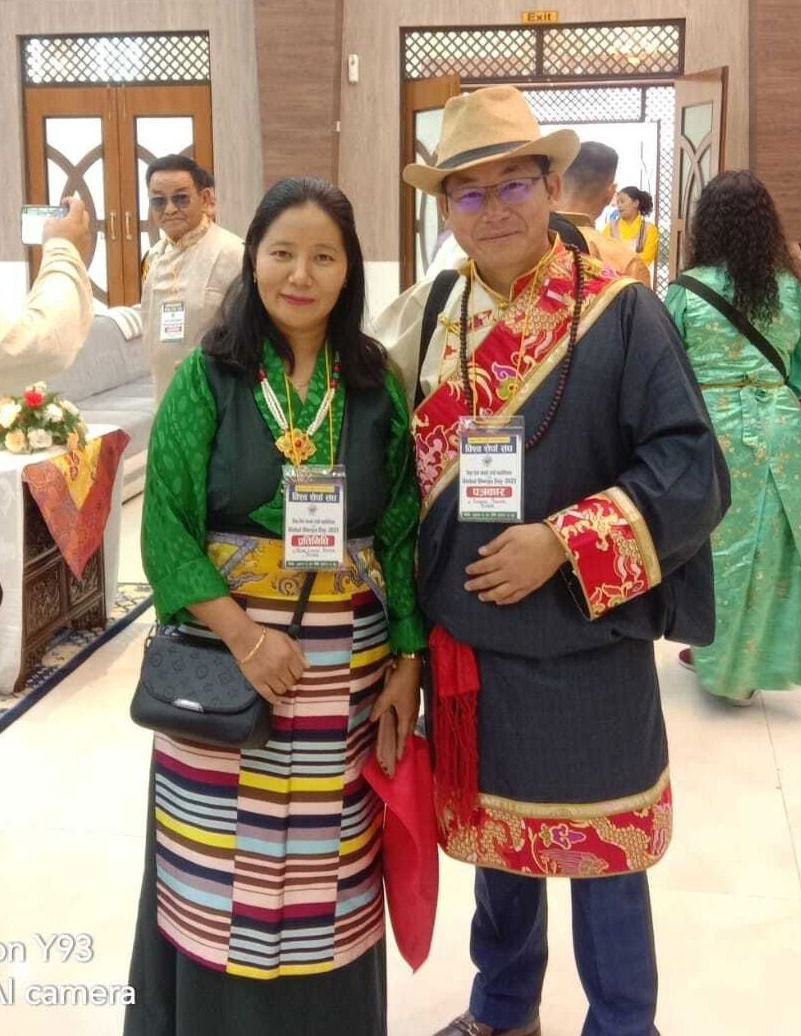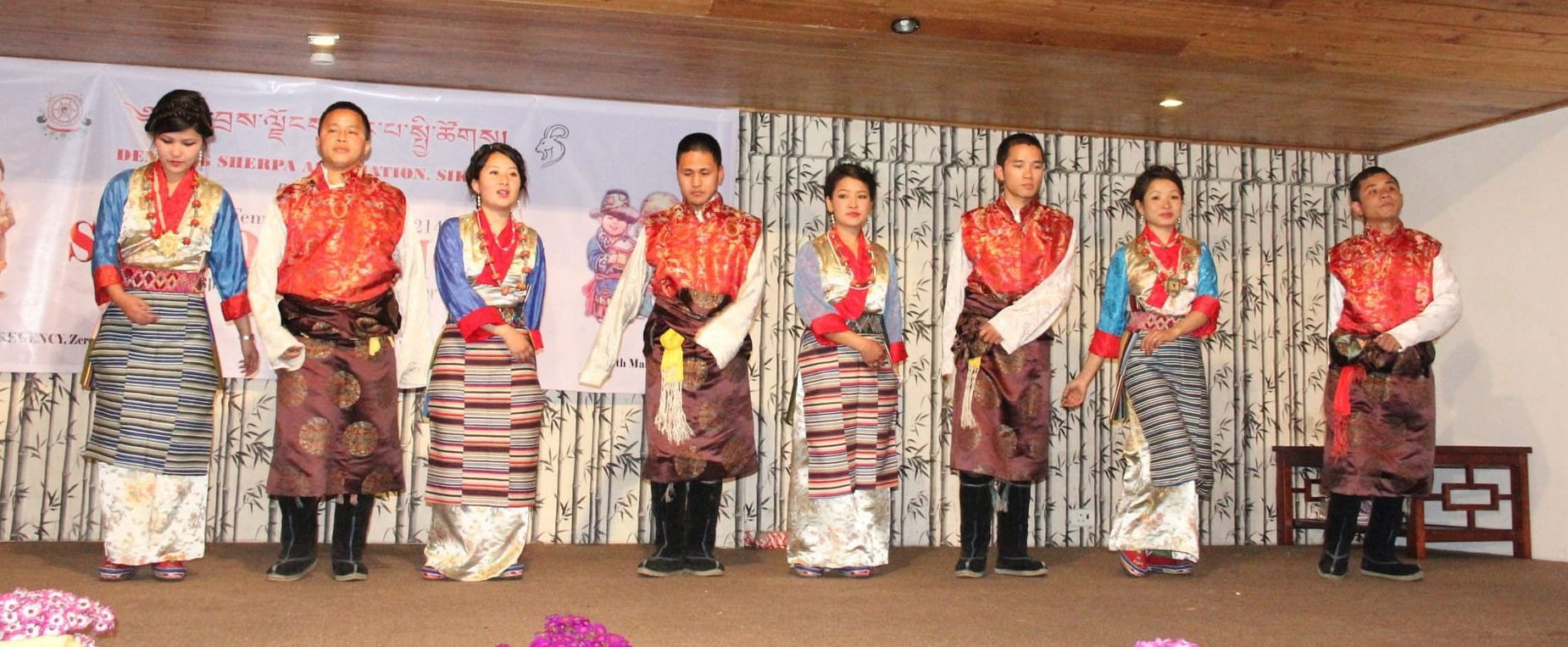
The Sherpa is an ethnic group that lives on the higher mountainous region mainly distributed in every districts of Sikkim. Sherpa shares a common Tibeto-Burman language and follows an ancient form of Buddhism tradition.
There was a time when Sikkim had territories that was spread across the larger portion, the boundary in the north was Dipdala in the north, Shingsa Dag-Pay, Walang, Yangmag Khangchen Yarlung and Timur Chorten in the west, down along the Arun and Dudh Kosi rivers, down to the Maha Nodi, Nuxulbari and Titaliyain the south, on the east Tagong La and Tang La on the north (subba, 2007; 289). Similarly Sherpa settlement is found in the Sikkim, Tibet, and eastern side of Nepal, Darjeeling, Bhutan, (Europe and America).
Showing areas with higher concentration of Sherpa population in Sikkim
| Districts | Areas with higher concentration of Sherpas population |
| West district (Gyalsing & Soreng District) | Ribdi, Bharang, Okharey, Upper Thambong, higher elevation of Tashiding, Uttarey, Begha, Upper Bermoik, Siribadam, Singling and Buriakhop. |
| South district (Namchi District) | Ralang, Nayabusty, Wok, Dew-Damthang, Jaubari, Basghari, Perbing, Temi, Namchi, Kewzing, Bermoik-Palak, Phali-Parengtaar, Ben and Thingrithang. |
| East district (Gangtok & Pakyong District) | Premlakha, Phadamchen, Nimachen, Bouchen, Phengdong, Agamlok, Dokchen, Lafa, Chujachen, Rongli, JN Road, Changu, Gnathang, Kupup, Pathing, Khamdong, Tokchi, Thek, Busuk and Bojoghari. |
| North district (Mangan District) | Kabi Lingchom, Gairi, Ghaikhana |
SHERPA CLAN
Sherpas are divided into various paternal clans group and sub-groups. Ru literally means “bone’: Sherpa believe that a child inherits bone from the father and blood from the mother. It is generally accepted that the four original Clans (Lama Serpa, Chawa, Minyagpa and Thimmi) came into existence as paternal clans. Other clans are formed as sub-clans of the original four paternal clans.
The Lama clan came as the Lama Serpa and Lama Gonpa brother clans. The chawa remained a single clan that originated from a lama and his family. The Thimmi clan gave rise to the Salakha, Lhakshinto, Kambache, Goparma, Paldorje, Binagpa, Mendowa and Chhusharwa. The Minyagpa gave rise to the Pinasa, Gole, Gartza, Pangkarma, Thakto, Khapa, Penagpa, Shari-topa and Yulgongma brother clans. Sherpa custom does not allow marriage between members of the same clan or brother clans.
FESTIVALS

Sherpas of Sikkim are originally of Buddhist faith and almost all the customs, culture and traditions are shaped by the philosophy of Buddhism belief. They celebrate Losar and Chirim Lhapsang as their main festival. Other than that Sherpa also celebrated Saga Dawa, Drukpa Tshechi, Buddha Jyanti and Lhabab Duchen. These occasions are religious in nature, with important participation by Lamas and monks. The main deity of Sherpas is Deo Padma Sambat or (Guru Rimpochay). Gumpas are found in almost all Sherpa villages, where they gather together to celebrate their festivals in an epic scale. Losar is the festival celebrated by them at the start of their new year normally in the month of February. During the festivals people put on their best costumes and wear their jewelry. These are generally made from yak and sheep wool, colored with natural dye. The woolen clothing is thick to suit the cool environment of the Himalayan highlands. Chirim Lhapsang festival is a community sponsored deity worshiping ceremony that takes place in villages. It is meant to invoke the protector deities seeking protection of land, crops, livestock and the people.
RELIGION
The Sherpas are the followers of the Nyingmapa sect of Buddhism. Many of the great Himalayan Mountains are worshiped as gods. Each Sherpa villagers recognizes mountain gods identified with certain peaks that are their protective deities. The Sherpa perform many rituals for different purposes. Rituals are performed to heal sickness, to appease deities, to promote peace, to earn religious merit and to avoid misfortune. Many of these ritual traditions are inherited from the ancient Phenpu (Bon) religion. Rituals are performed by learned priests, village shamans and lay practitioners alike. They require particular ritual items or objects. Most wooden ritual objects are locally made whereas the finer metallic objects are imported from elsewhere.
SHERPA FOODS

The Sherpas are usually non-vegetarian. The Sherpa staple food is potato and wheat from which they prepare varieties of items for their consumption. In addition, they use to drink sujya (tea served with salt and butter) at all meals and throughout the day. A typical breakfast consists of sujya andchhampha(roasted barley flour) is taken usually. Lunch is eaten in the late morning and may include boiled potatoes which are dipped in ground spices. In the dinner they like to take shen (stiff dough made from flour of grain) with somarshundur (soup of preserved soft cheese) and nurma/durma (mash with potato’s gravy specially served with stiffed dough). In the Sherpa society their special food is femar (a mixer of roasted corn flour and butter). It is very necessary food in the marriage ceremony. Their some food varieties are; boiled potato with a pickle of aermang (timboor), chhampha (roasted barley flour), rigikur (potato bread), fe-shen (stiff dough made from flour of grain), rildok (mashed potato mixed with wheat flour), pakril (food made from wheat and bread), momo (steam food made from wheat flour with mixing of vegetables & meet), chhen (dried greencorn mixed with meet or vegetable commonly known as phalgi), shakpa/aeri (a typical strew food consisting of balls of dough & vegetable), nurma/durma (mash with potato’s gravy specially served with stiffed dough), thukpa (noodle made from wheat flour), towa (noodle made from potato), kaksyer (raw corn flex), sharkam (soup of soft fresh cheese) etc are occasionally and seasonally consumed. Dairy products, especially butter and curds, are important in the Sherpa diet. Sherpas eat meat, but as practicing Buddhists they will not kill animals themselves.
SHERPA TRADITIONAL DRESSES

Sherpa dresses are similar to that worn by Tibetans. Sherpas live in the high altitude thus it is cold all the year round. For many months the land is snowcovered. The clothing and costumes of the Sherpa people were/are generally made from yak and sheep wool, and colored with natural dye. The wool clothing is very thick to suit the cold environment. Men wear their chhuba to knee length and under it they have a jacket or shirt with a stiff high collar and extremely long sleeves tetung. Women wear a sleeveless chhuba called engi, or a sleeved one called tongok. Over it they wear multicolored striped woolen aprons worn to cover the front and back of the bodies below the waist which is called pangden and gyaptil respectively. Both sides of pangden have a kingkap (triangle shape stiff) which determines the marital status of the woman.Both males and females wear high, woolen boots with hide soles (docha). The uses of traditional clothing are being confined to a ceremonial occasions. Only Sherpa women, monks and nuns are wearing traditional dresses at all the season. Traditional shyomung (woolen hat) completes the dresses of Sherpa men and women.
SHERPA ORNAMENTS
Sherpa Jewelry is very unique and different from the others. There is the apron buckle which is called kyetig. It is a silver buckle that women use to hold the back and the front of their aprons. There are some ornaments which Sherpa women wear in ceremonial occasion and some of them were wear all the time in the villages. They are dzhichhuruk(onyx with coral), mathil (golden bracelet), kaau (golden pendant),inanila (sapphire),dzhi (onyx), pykurkukte (earring), chapchap (silver batch), gyanjyan (golden necklace),dikra (silver and golden chain that is hold in the front waist to the right side shoulder) and tiktik (necklace worn on a special occasion). Lastly, there is an alung. This is a men’s earing. These earrings are made of gold and they have turquoise or coral insets.

SHERPA SONGS & DANCES
Sherpa communities have a rich tradition of folk songs and dances. They sing folks songs to bonds people together, uplifts their spirits and provides recreation and rejuvenation. There is a traditional Sherpa saying –Lu min taam yin – which means songs are not just songs but are a medium of communication. They singselo (Sherpa selo), tashi-sol-che and yangdosiba. Shebdro song is very much popular in the Sherpa community across the world. They perform folk dances such as shebru dance (group dance perform by connecting hands), shyaptuk dance (group dance), nading dance (dance by tapping foot), tashi-sol-che dance (dance performed in marriage ceremony), yangdosiba (ceremonial dance), silluwa dance (the dance performed in marriage ceremony by two dancers with holding sword and yak’s tail), Khayirolyang dance (traditional instrumental dance), dramngyang dance (traditional instrumental dance),chyakikargna dance (traditional instrumental dance), khirkhuley dance (foot stepping dance) and yungmakabu dance (bamboo dance).

ZENDI (SHERPA TRADITIONAL WEDDING)
One of the most important events in Sherpa culture is Tartang/Zendi (Merriage). A marriage is arranged by the mutual consent of the couples’ parents, often respecting the veto of the child. The traditional Sherpa wedding is a lengthy process lasting more than a week. The wedding practices are carried out mainly for propose of bestowing happiness and prosperity in the couple’s married life. A Sherpa wedding consists of several stages.

- Longchhang: “Longchhang” is the proposal by the boy’s parents to the girl’s parents asking the hand of the girl in marriage.
- Thichhang: Once the boy and the girl are betrothed, the boy’s and the girl’s parents start preparing for the upcoming marriages processes. “Thichhang” refers to asking the girl’s parents about the necessary things that they need to prepare and bring during the wedding day.
- First Pechang: A process called Pechhang, a small meeting between the parents of the girl and the boy’s family, is conducted to make necessary decisions for the wedding.
- Demchhang: Having received the approval from the girl’s parents regarding the marriage, the boy’s parents move towards the process named as “Demchhang”. It is considered as one of the important processes in the sense that the girl is now considered as the member of the bridegroom’s family. It also marks the completion of half of the marriage process.
- Chhyawi: In the next step called “Chhyawi”, the boy’s parents provide many bags of millet mixed with maize, approximately thirty “pathi” for wine preparation to the girl’s parents. One “pathi”, is the amount weighing four kilograms.
- Second Pechang: Two or three weeks prior to the wedding day, the boy’s and the girl’s family members hold a gathering of the villagers to inform them about the marriage. The parents ask for the villagers’ support during the wedding. The members of the bride and the bridegroom ask the villagers and their relatives to estimate how many people will be present during the wedding day. Then the preparation for the wedding day starts.
- Zendi or Chhangdu (the wedding day): “Sippa Khorlo”, a special flag which is representing the wheel of cycle existence. It holds in front of janti (procession). It is believed that the Khorlo protects the “Janti” from all the evils that they may encounter on the way to the girl’s home. It is believed to overpower all the evils that come from any of the direction it faces. The groom takes Dhattar, Phumba and Duflong along with him and the main Ngagpa (married priest) carries with him the SippaKhorlo. The dancers carry Sword, Bukchal (cymbals), Gelings (long metallic flutes) and yak’s ngama (yak’s tail). The “janti” also take the requested number of phemar, wine,khatak and chhang. These kinds of cymbals: one small and two large, distinguished with small bosses (Sil-nyen) are held vertically and used in offerings to peaceful deities. Those with large central bosses (Buk-chal) are held horizontally and used in prayers to fierce deities. The small cymbals (Ting-sha) are used in offering rituals. Dhattar represents a stick fastened with five different striped clothes. Dhattar is thought to bring power and prosperity. Phumba is a pot, the shape of which is like a flat shaped jar with a pipe to bring out the water from the pot and which is richly decorated with precious stones and metals. Phumba is normally found placed on altar in the Sherpa homes to keep water perhaps the most important in Buddhist rituals, as an offering to the god. Phumba is thought to increase the life span of the bridegroom. During the wedding, the use of many instruments comes into play. The sounds of instruments are thought to bring us closer to the Gods by making people happy, one of the many small steps on the path to the enlightenment. The bride wears five layers of clothes topped up by floor-length-embroidered tunic and two aprons. The bridegroom is dressed in a colorful chuva that is symbolic of a king whereas that of the bride is symbolic of a Queen. He is treated like a king with an umbrella carried by the Kelmi over his head. The Kelmi is the best man usually his cousin or brother who is not yet married. The bride’s parents introduce themselves to the bridegroom’s party and kindly ask whether their journey was safe and enjoyable. This process is known as NgosiTomsi. The host family hands Siljang, a chhang which is offered to the bridegroom as an indication that he is now free to take his cloak off and to take some rest. When this has been done, the bridegroom’s parents hand over kyakiphemar and khatak to the bride’s parents and relatives. Parents of the bride’s family then greet the guest and inquire whether their journey has been safe and peaceful. All the guests then have their dinner. Some important members of the groom enter the girl’s home to present Phemars and Khataks. In the mean time, guns are fired in the air outside the home. This process is known as Chhini Gegug. Once again both the party of the bridegroom and the bride perform SyorkiTomsi to each other. The Ngagpa then reads out Mola, a public announcement of the marriage. The Ngagpa who recites Mola should have a good knowledge of the religion; its history, significance and its association to the wedding. He is given Khatak and Chhang by the members of the bride and the bridegroom, cordially requesting him to read out the Mola on their behalf. Then all the guests rhythmically utter in loud voice “Khu-A, Khu-A” in a wave like fashion to show their acceptance of the marriage. In other words,Khu-A means that we now happily accept the girl then followed by the song sung by the members of the groom. The marriages are treated as holy union between two souls. It has always been an event of social and customary importance.
NAME GIVING CEREMONY
The name-giving ceremony of a Sherpa child is an important event. The local lama (Buddhist spiritual leader) is informed of the birth and the time that it occurred. On the basis of this information, the lama determines the child's name and when the naming ceremony should take place. Children,their first name is often named after the name of the day of the week on which they were born. Thus a baby born on Friday would be called "Pasang" (the Sherpa word for "Friday"). The lama, relatives, and neighbors are invited to celebrate the name-giving at a feast.
DEATH RITUALS

Funerals are the longest and most elaborate life-cycle ceremonies; the body is cremated, and the soul of the deceased is encouraged, through ritual action and instruction, to seek an advantageous rebirth.When a person dies, lamas are called immediately to perform rituals to try to generate good, positive energy for the deceased. There are many different customs, but, usually, the body is kept for three days then cremated. The remnants of the fire mixed with clay and are made into tsatsa that are left in achortenor under a large rock at the end of 49 days. Every seven days after the death, special prayers (denjen) are offered in the homeof the deceased or in the monastery until 49 days. One head lama is staying at the deceased home and every morning and evening in the same time the head lama offeringsurbi(mixture of nine items made by chhampa, minduk, milk, cord, butter, honey, black suger, sakker) on the fire’s hot coals for the spirit of the deceased until 49 days. The Bardo for 49 days after the death is the time and space between lives, by the end of which the person’s next life is determined and they may be reborn.